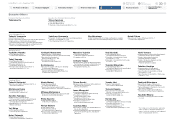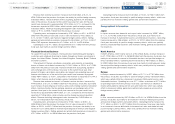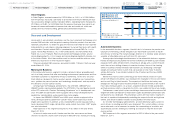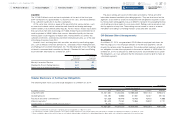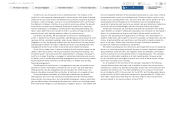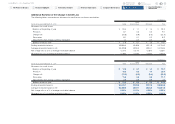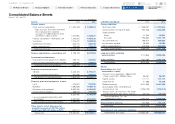Honda 2014 Annual Report Download - page 39
Download and view the complete annual report
Please find page 39 of the 2014 Honda annual report below. You can navigate through the pages in the report by either clicking on the pages listed below, or by using the keyword search tool below to find specific information within the annual report.
If our estimates of unrecognized tax benefits and potential tax benefits are not
representative of actual outcomes, our consolidated financial statements could be
materially affected in the period of settlement or when the statutes of limitations
expire, as we treat these events as discrete items in the period of resolution. Since
it is difficult to estimate actual payment in the future related to our uncertain tax
positions, unrecognized tax benefit totaled ¥6,983 million is not represented in the
table above.
As of March 31, 2014, we had no material capital lease obligations or long-
term liabilities reflected on our balance sheet under U.S. GAAP other than those
set forth in the table above.
Application of Critical Accounting Policies
Critical accounting policies are those which require us to apply the most difficult,
subjective or complex judgments, often requiring us to make estimates about the
effect of matters that are inherently uncertain and which may change in sub-
sequent periods, or for which the use of different estimates that could have
reason ably been used in the current period would have had a material impact on
the presentation of our financial condition and results of operations. Further
changes in the economic environment surrounding us, effects by market conditions,
effects of currency fluctuations or other factors have combined to increase the
uncertainty inherent in such estimates and assumptions.
The following is not intended to be a comprehensive list of all our accounting
policies.
We have identified the following critical accounting policies with respect to our
financial presentation.
Product Warranty
We warrant our products for specific periods of time. We also provide specific
warranty programs, including product recalls, as needed.
Product warranties vary depending upon the nature of the product, the
geographic location of their sales and other factors.
We recognize costs for general warranties on products we sell and for specific
warranty programs, including product recalls. We provide for general estimated
warranty costs at the time products are sold to customers. We also provide for
specific estimated warranty program costs at the time those costs for new war-
ranty programs are deemed to be probable and can be reasonably estimated.
Estimated warranty costs are provided based on historical warranty claim experi-
ence with consideration given to the expected level of future warranty costs,
including current sales trends, the expected number of units to be affected and
the estimated average repair cost per unit for warranty claims. Our products
contain certain parts manufactured by third party suppliers. Since suppliers
typically warrant these parts, the expected receivables from warranties of these
suppliers are deducted from our estimates of accrued warranty obligations.
We believe our accrued warranty liability is a “critical accounting estimate”
because changes in the calculation can materially affect net income attributable to
Honda Motor Co., Ltd., and require us to estimate the frequency and amounts of
future claims, which are inherently uncertain.
Our policy is to continuously monitor warranty cost accruals to determine the
adequacy of the accrual. Therefore, warranty expense accruals are maintained at
an amount we deem adequate to cover estimated warranty expenses.
Actual claims incurred in the future may differ from the original estimates,
which may result in material revisions to the warranty expense accruals.
The changes in the accrued liabilities for those product warranties and net
sales and other operating revenue for each of the years in the three-year period
ended March 31, 2014 are as follows:
Yen (millions)
Fiscal years ended March 31 2013 2014
Provisions for product warranties
Balance at beginning of year ¥ 170,562 ¥ 208,033
Warranty claims paid during the period (64,942) (104,090)
Liabilities accrued for warranties issued
during the period 97,108 153,898
Changes in liabilities for pre-existing
warranties during the period* (8,583) 397
Foreign currency translation 13,888 11,382
Balance at end of year 208,033 269,620
Net sales and other operating revenue ¥9,877,947 ¥11,842,451
*1 Liabilities accrued for warranties issued during the period for the fiscal year ended March 31, 2014, was
¥153.8 billion, due mainly to the future warranty costs for product recalls in Automobile business.
*2 Changes in liabilities for pre-existing warranties during the period for the fiscal year ended March 31, 2012,
was ¥17.6 billion, due mainly to the change of the expected level of future warranty costs, including the
expected number of units to be affected and estimated average repair cost per unit for product recalls.
Credit Losses
Our finance subsidiaries provide retail lending and leasing to customers and
wholesale financing to dealers primarily to support sales of our products. Honda
classifies retail and direct financing lease receivables (consumer finance receiv-
ables) derived from those services as finance subsidiaries-receivables. Operating
leases are classified as property on operating leases. Certain finance receivables
related to sales of inventory are included in trade accounts and notes receivable
and other assets in the consolidated balance sheets.
Honda Motor Co., Ltd. Annual Report 2014 38
6 Financial Section
1 The Power of Dreams
2 Financial Highlights
3 To Our Shareholders
4 Review of Operations
5 Corporate Governance
7
Investor Relations
Information
Return to last
page opened
Go to
contents page




